Art History - Test 1
5.0(1)
Card Sorting
1/41
Earn XP
Description and Tags
Study Analytics
Name | Mastery | Learn | Test | Matching | Spaced |
|---|
No study sessions yet.
42 Terms
1
New cards
Venus of Willendorf - Paleolithic
-Limestone, 4 ¼" high
-Carried (no stand)
-Good luck charm?
-Many versions (emphasized same features)
-Hair is disputed (hair style? hat?)
-Carried (no stand)
-Good luck charm?
-Many versions (emphasized same features)
-Hair is disputed (hair style? hat?)
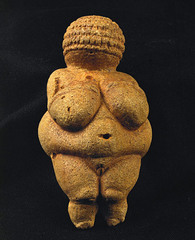
2
New cards
Bison with Turned Head - Paleolithic
-Approx. 4" long
-Reindeer horn spearthrower
-Gave arm an "extra joint" for greater distance for spear
-Like modern dog ball throwers
-Reindeer horn spearthrower
-Gave arm an "extra joint" for greater distance for spear
-Like modern dog ball throwers
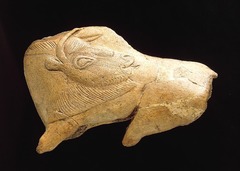
3
New cards
Wounded Man, Disembowled Bison - Paleolithic
-Bird may be scepter or walking stick
-Lascaux, France
-Display silhouettes and outlines, indicating that two different painters created them at perhaps different times
-Twisted perspective/composite view (viewers see heads in profile, but horns from the front
-First art including a man?
-Lascaux, France
-Display silhouettes and outlines, indicating that two different painters created them at perhaps different times
-Twisted perspective/composite view (viewers see heads in profile, but horns from the front
-First art including a man?
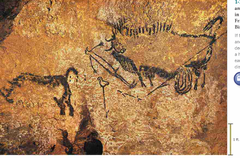
4
New cards
Human Skull with Restored Features - Neolithic Jericho
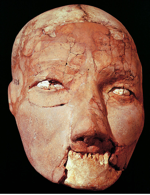
5
New cards
Human Figure from Ain Ghazal - Neolithic Jordan
-Plaster, painted and inlaid with cowrie shell
-Different ideas on purpose/meaning
-Ancestor worship (make object to recognize ancestry, pray to ancestors, sacrifice to ancestors)
-Different ideas on purpose/meaning
-Ancestor worship (make object to recognize ancestry, pray to ancestors, sacrifice to ancestors)

6
New cards
Stonehenge - Neolithic England
-Wiltshire, England
-Solar calendar
-Marks summer and winter solstice
-Heel stone has the sun set directly behind it once a year
-Meeting ground
- possibly funeral place
-Solar calendar
-Marks summer and winter solstice
-Heel stone has the sun set directly behind it once a year
-Meeting ground
- possibly funeral place
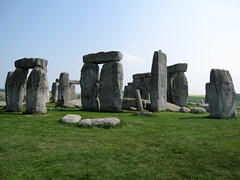
7
New cards
Warka Vase - Sumerian
-Alabaster, 3' ¼" high
-Likely dedicated to Inanna
-People depicted bringing baskets of things to dedicate/sacrifice
-2 theories: ritualistic marriage between priest and Inanna OR priest is just bringing gifts
-Either way, gives power to the priest (aligned with deity)
-Rows are called "registers"/"freezes"
-Tells a story through a sequence of imagery
-More sophisticated than cave paintings'
-Also implies a hierarchy (most important people are biggest)
-Likely dedicated to Inanna
-People depicted bringing baskets of things to dedicate/sacrifice
-2 theories: ritualistic marriage between priest and Inanna OR priest is just bringing gifts
-Either way, gives power to the priest (aligned with deity)
-Rows are called "registers"/"freezes"
-Tells a story through a sequence of imagery
-More sophisticated than cave paintings'
-Also implies a hierarchy (most important people are biggest)
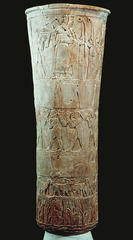
8
New cards
White Temple and Ziggurat - Sumerian
-Uruk, Iraq (ancient Sumer)
-Predates "The Old Kingdom" (when pyramids were being built)
-Temples made up the "nucleus" of each of the city-states
-Base made of mud bricks (no access to stones)
-Most temples lost to time because water eroded the mud bricks
-"Whitewashed" top with materials
-Commoners not permitted
-Intended to commune with the gods, built high up, only some approved to
-Thought to be dedicated to Anu, Sky god
-Corners point to the cardinal directions
-Called a "waiting room" because it was believed that the gods would descend into it one day
-Predates "The Old Kingdom" (when pyramids were being built)
-Temples made up the "nucleus" of each of the city-states
-Base made of mud bricks (no access to stones)
-Most temples lost to time because water eroded the mud bricks
-"Whitewashed" top with materials
-Commoners not permitted
-Intended to commune with the gods, built high up, only some approved to
-Thought to be dedicated to Anu, Sky god
-Corners point to the cardinal directions
-Called a "waiting room" because it was believed that the gods would descend into it one day
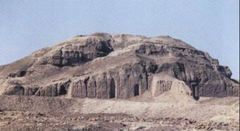
9
New cards
Two Worshippers from Square Temple - Sumerian
-Gypsum inlaid with Black Shell, 2' 6" high
-Thought to be an effegy/stand-in for worshippers
-Eternal wakefulness to be able to worship 24/7 (worships on their behalf)
-Heads tilted up in wait for the gods to descend
-Thought to be an effegy/stand-in for worshippers
-Eternal wakefulness to be able to worship 24/7 (worships on their behalf)
-Heads tilted up in wait for the gods to descend
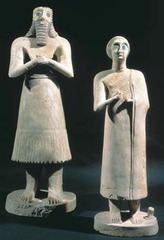
10
New cards
Standard of Ur - Sumerian
-War side (top), peace side (bottom)
-Wood inlaid with shell, lapis lazuli, red limestone, 8" x 1' 6"
-"Standard" is a thing (flag, depiction, etc.) that leads into battle
-Originally thought to be that, now thought to be a sound box or something else
-Lapis lazuli was imported (cultures were shared)
-Found in so-called "Royal Cemetary of Ur"
-Wood inlaid with shell, lapis lazuli, red limestone, 8" x 1' 6"
-"Standard" is a thing (flag, depiction, etc.) that leads into battle
-Originally thought to be that, now thought to be a sound box or something else
-Lapis lazuli was imported (cultures were shared)
-Found in so-called "Royal Cemetary of Ur"
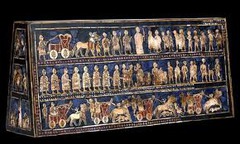
11
New cards
Victory Stele of Naram-Sin - Akkadian
-Pink sandstone, 6' 7" high
-Stele = vertical, carved stone
-Similar to gravestone
-War monument, tells a story
-Commemorates victory over Lulubai (nomadic neighbors)
-King shown with bull-horned helmet only worn by gods (king is a god)
-Stars show the gods approval
-Stele = vertical, carved stone
-Similar to gravestone
-War monument, tells a story
-Commemorates victory over Lulubai (nomadic neighbors)
-King shown with bull-horned helmet only worn by gods (king is a god)
-Stars show the gods approval
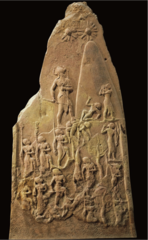
12
New cards
Stele with Law Code of Hammurabi - Babylonian
-Basalt, 7' 4" high
-Not the only law code preserved
-"Eye for an eye"
-Prevent the strong from taking advantage of the weak
-Often a class distinction where higher classes were given easier punishments
-Depicts Hammurabi being granted authority/approval by the god
-Not the only law code preserved
-"Eye for an eye"
-Prevent the strong from taking advantage of the weak
-Often a class distinction where higher classes were given easier punishments
-Depicts Hammurabi being granted authority/approval by the god

13
New cards
Last Judgement of Hu Nefer - Egyptian
-Painted papyrus, Abu Simbel, Egypt
-Tells the story of his seeking eternal life
-Went through 42 questions to weigh his heart against the feather
-Heart eaten by ammit if it was heavy
-Tells the story of his seeking eternal life
-Went through 42 questions to weigh his heart against the feather
-Heart eaten by ammit if it was heavy
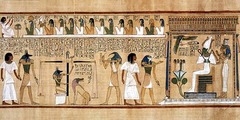
14
New cards
Palette of King Narmer - Egyptian
-Slate, approx. 2' 1" high, from Hierkonoplis, Egypt Predynastic, Ca.
-Commemorated political unification of Egypt
-Not one momentous event; happened over time
-Long-necked creatures represent both sides of Egypt
-Egyptian art doesn't change much
-Art was done for tradition and language with a distinct purpose, not for aesthetics
-Gods don't change, so why would you depict them differently?
-Ceremonial palette, as opposed to a palette used to grind the pigment for their eyes
-Commemorated political unification of Egypt
-Not one momentous event; happened over time
-Long-necked creatures represent both sides of Egypt
-Egyptian art doesn't change much
-Art was done for tradition and language with a distinct purpose, not for aesthetics
-Gods don't change, so why would you depict them differently?
-Ceremonial palette, as opposed to a palette used to grind the pigment for their eyes
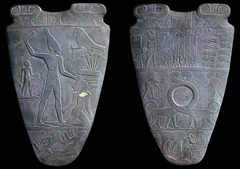
15
New cards
Great Pyramids of Gizeh - Egyptian
-Fourth Dynasty
-These took on the shape of the ben-ben, the emblem of the sun god Re
-The ben-ben arose out of a sea of chaos (origin story)
-Atum (originator god) made it with thoughts
-Not necessarily a refined form of the mastaba, but does represent the architectural evolution that started with the mastaba
-The pyramids are symbols of the sun
-The sun's rays were the "ramp" the pharaoh used to ascend to the heavens after their death and rebirth
-The pyramid was a giant stairway
-Four corners are oriented to the cardinal directions
-Only wonder of the ancient world that is still standing
-Pyramid on the dollar bill because it represents lasting forever
-Three major pyramids within 75 years for Fourth Dynasty kings Khufu, Khafre, and Menkaure
-Unlike Djoser's temple on the north side facing the stars of the northern sky, these temples are on the east side facing the rising sun
-These took on the shape of the ben-ben, the emblem of the sun god Re
-The ben-ben arose out of a sea of chaos (origin story)
-Atum (originator god) made it with thoughts
-Not necessarily a refined form of the mastaba, but does represent the architectural evolution that started with the mastaba
-The pyramids are symbols of the sun
-The sun's rays were the "ramp" the pharaoh used to ascend to the heavens after their death and rebirth
-The pyramid was a giant stairway
-Four corners are oriented to the cardinal directions
-Only wonder of the ancient world that is still standing
-Pyramid on the dollar bill because it represents lasting forever
-Three major pyramids within 75 years for Fourth Dynasty kings Khufu, Khafre, and Menkaure
-Unlike Djoser's temple on the north side facing the stars of the northern sky, these temples are on the east side facing the rising sun
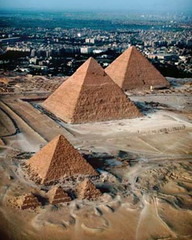
16
New cards
Model of the Pyramid Complex, Gizeh- Egyptian
- entire funerary complex at Gizeh
- served as the king's tomb, temple, and palace in the afterlife
- included the burial chamber, the mortuary temple where the priests made offerings and stored items, the roofed causeway (raised road) leading to the mortuary temple, and the valley temple at the edge of the floodplain
- served as the king's tomb, temple, and palace in the afterlife
- included the burial chamber, the mortuary temple where the priests made offerings and stored items, the roofed causeway (raised road) leading to the mortuary temple, and the valley temple at the edge of the floodplain
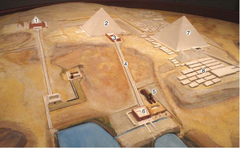
17
New cards
Great Sphinx - Egyptian
-Gizeh, Egypt, sandstone
-Zoomorphic imagery
-Combined human intelligence with strength and authority of a beast/lion
-Faces the east (sunrise) and aligned with the journey of the sun
-Sun as life and power
-The dead person follows the sun's rays up to heaven
-Zoomorphic imagery
-Combined human intelligence with strength and authority of a beast/lion
-Faces the east (sunrise) and aligned with the journey of the sun
-Sun as life and power
-The dead person follows the sun's rays up to heaven

18
New cards
Khafre Enthroned - Egyptian
-Diorite, 5' 6" high, Old Kingdom, Gizeh, Egypt
-Diorite is a hard material (hard to carve, hard to obtain)
-Meant to last and service as a surrogate mummy in case it was stolen (keep the ks)
-No negative spaces (gestalt) to get snapped off
-Center tomb/pyramid
-Symmetrical (divine, perfect) and idealized
-Papyrus and lotus leaf symbolized both sides of Egypt (king of all of Egypt)
-Diorite is a hard material (hard to carve, hard to obtain)
-Meant to last and service as a surrogate mummy in case it was stolen (keep the ks)
-No negative spaces (gestalt) to get snapped off
-Center tomb/pyramid
-Symmetrical (divine, perfect) and idealized
-Papyrus and lotus leaf symbolized both sides of Egypt (king of all of Egypt)
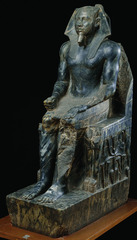
19
New cards
Menkaure and Khamerernebty - Egyptian
-Graywacke, Approx. 4' 6" high, Old Kingdom, Gizeh, Egypt
-King and Queen or King and Mother
-Convention of painting men with red ochre and women with yellow ochre (remnants of the paint on them)
-Didn't signify skin color, just gender
-Arms interlocked symbolizing connection
-Stepping forward with left foot, but hips stayed level unnaturally (not showing naturalism, showing timelessness/stillness that is suitable for a god)
-King and Queen or King and Mother
-Convention of painting men with red ochre and women with yellow ochre (remnants of the paint on them)
-Didn't signify skin color, just gender
-Arms interlocked symbolizing connection
-Stepping forward with left foot, but hips stayed level unnaturally (not showing naturalism, showing timelessness/stillness that is suitable for a god)

20
New cards
Seated Scribe - Egyptian
-From mastaba at Saqqara, Egypt, Painted limestone, approx. 1' 9" high
-Limestone was easy to get, no exotic features to denote importance
-Notice the realism compared to the pharaohs
-This is because the scribe was not divine, he was "imperfect", human
-The vast majority of Egyptians were illiterate
-It's been said that it could take up to ten years to learn heiroglyphics, which contained almost 700 characters
-Scribes were like the internet of ancient Egypt
-The main conduit for recording and conveying information
-Highly educated
-Different roles (historians, scribing chants/prayers, convey information to separate part of Egypt, etc.)
-Trusted
-Tradition of higher social status=more formal portraits and lower social status = less formal portraits
-This was still used as a surrogate home for the mummy if it was destroyed
-Limestone was easy to get, no exotic features to denote importance
-Notice the realism compared to the pharaohs
-This is because the scribe was not divine, he was "imperfect", human
-The vast majority of Egyptians were illiterate
-It's been said that it could take up to ten years to learn heiroglyphics, which contained almost 700 characters
-Scribes were like the internet of ancient Egypt
-The main conduit for recording and conveying information
-Highly educated
-Different roles (historians, scribing chants/prayers, convey information to separate part of Egypt, etc.)
-Trusted
-Tradition of higher social status=more formal portraits and lower social status = less formal portraits
-This was still used as a surrogate home for the mummy if it was destroyed
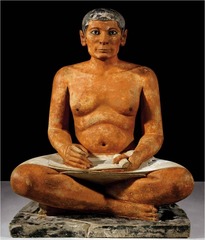
21
New cards
Fragmentary Head of Senusret - Egyptian
-Red Quartzite, approx. 6.5" high
-Showed humanity in his commissions, still idealized body
-Fought four campaigns in Nubia, but never achieved secure control over the Nubians
-Was successful in establishing a more powerful central government in Egypt
-Showed humanity in his commissions, still idealized body
-Fought four campaigns in Nubia, but never achieved secure control over the Nubians
-Was successful in establishing a more powerful central government in Egypt
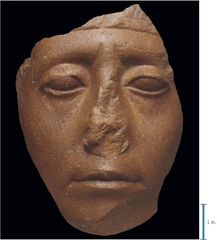
22
New cards
Mortuary Temple of Hatshepsut - Egyptian
(Note: NOT the same image as on the slides)
-The first monumental tribute to a woman's achievement in the history of art
-Not the first female pharaoh
-Sometimes the mother would take over for her son if the father died when the son was too young (she was a "regent")
-Hatshepsut took over as a regent and used her power to create a narrative of why she should be ruler permanently
-Used art to show Osiris giving her power and show her power
-Ruled for 20 years
-Has a temple for Amun-Re
-Once a year had a festival where they brought around a sculpture to Amun-Re (taken from East side to west side by Nile and into this temple for 1 night
-The first monumental tribute to a woman's achievement in the history of art
-Not the first female pharaoh
-Sometimes the mother would take over for her son if the father died when the son was too young (she was a "regent")
-Hatshepsut took over as a regent and used her power to create a narrative of why she should be ruler permanently
-Used art to show Osiris giving her power and show her power
-Ruled for 20 years
-Has a temple for Amun-Re
-Once a year had a festival where they brought around a sculpture to Amun-Re (taken from East side to west side by Nile and into this temple for 1 night
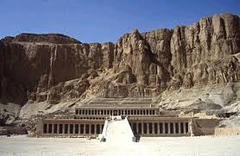
23
New cards
Hatshepsut with Offering Jars - Egyptian
-From the upper court of her mortuary temple, red granite, Gizeh, Egypt
-Pharaohs only kneeled to gods
-Portrayed as a male
-Later generations resented that she was a female ruler
-Iconoclasm, destroyed her art to destroy her power
-Pharaohs only kneeled to gods
-Portrayed as a male
-Later generations resented that she was a female ruler
-Iconoclasm, destroyed her art to destroy her power
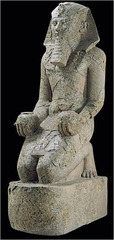
24
New cards
Amenhotep IV, later known as Akhenaton - Egyptian
-From temple of Aton, sandstone
-Different art style established by pharaoh
-Different theories, from him actually looking like that to it being a rebellion against the established style similar to the rebellion against the established religion
-Akhenaton = accepted by Aton
-Amarna Period
-Brief period where a pharaoh tried to recreate the world in his likeness
-Tried to establish new/different religion
-Amun-Re -> Aton
-Represented by sun disk, not human or animal
-Monotheistic (declared that all gods don't exist except Aton)
-Didn't take hold very well
-Put the temples/priests out of work
-A lot of his creations were destroyed after his death because everyone hated what he did
-Constructed mythology through artwork
-Decreed that the only way to communicate with Aton was through him (not priests, prayer, etc.)
-Claimed to be both son and sole prophet of Aton
-Changed art style (more exaggerated/stylized)
-Different art style established by pharaoh
-Different theories, from him actually looking like that to it being a rebellion against the established style similar to the rebellion against the established religion
-Akhenaton = accepted by Aton
-Amarna Period
-Brief period where a pharaoh tried to recreate the world in his likeness
-Tried to establish new/different religion
-Amun-Re -> Aton
-Represented by sun disk, not human or animal
-Monotheistic (declared that all gods don't exist except Aton)
-Didn't take hold very well
-Put the temples/priests out of work
-A lot of his creations were destroyed after his death because everyone hated what he did
-Constructed mythology through artwork
-Decreed that the only way to communicate with Aton was through him (not priests, prayer, etc.)
-Claimed to be both son and sole prophet of Aton
-Changed art style (more exaggerated/stylized)

25
New cards
Bust of Nefertiti by Thutmose - Egyptian
-Painted limestone
-Amarna period
-Different from before-establish style like other pieces in this period
-Nefertiti = “the beautiful one comes”
-Meant to be a prototype (not completed)
-Discovered in the workshop of Thutmose
-Amarna period
-Different from before-establish style like other pieces in this period
-Nefertiti = “the beautiful one comes”
-Meant to be a prototype (not completed)
-Discovered in the workshop of Thutmose
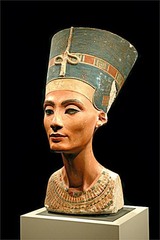
26
New cards
Tiye - Egyptian
-Yew wood with gold, lapis lazuli, silver, alabaster
-Akhenaten co-ruled with his mother and wife
-Mother was not royal blood, was demoted when her husband died
-Re-promoted when Akhenaten became pharaoh
-He elevated her to the status of goddess
-Amarna period (not idealized, has wrinkles)
-Akhenaten co-ruled with his mother and wife
-Mother was not royal blood, was demoted when her husband died
-Re-promoted when Akhenaten became pharaoh
-He elevated her to the status of goddess
-Amarna period (not idealized, has wrinkles)
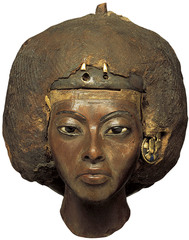
27
New cards
Death Mask of Tutankhamen - Egyptian
-Solid gold inlay of semiprecious stones
-Was 19 when he died (thought to have died unexpectedly)
-Final and most luxurious of 4 layers to his coffin
-Post-Amarna period
-Was 19 when he died (thought to have died unexpectedly)
-Final and most luxurious of 4 layers to his coffin
-Post-Amarna period

28
New cards
Pharaoh
-ancient Egyptian king
-only started to be used as a term in the New Kingdom
-only started to be used as a term in the New Kingdom
29
New cards
Dynasty
a series of rulers that share a common origin/were part of the same family (ruled until overthrown or none left to rule)
30
New cards
Palette
a slab used for preparing makeup
31
New cards
Narmer
The king who unified upper and lower Egypt at the end of the Predynastic period and start of the Dynastic period (First Dynasty)
32
New cards
Stepped pyramid
-pyramid that was composed of stacked mastabas
-marked the start of pyramids in Egypt (precursor to the Great Pyramids)
-first monumental structure built in stone
-marked the start of pyramids in Egypt (precursor to the Great Pyramids)
-first monumental structure built in stone
33
New cards
Imhotep
-master builder for King Djoser of the Third Dynasty
-first recorded name of an artist anywhere in the world
-also served as official seal bearer and high priest of the sun god Re (deified after his death)
-first recorded name of an artist anywhere in the world
-also served as official seal bearer and high priest of the sun god Re (deified after his death)
34
New cards
Great Pyramids
-Not necessarily a refined form of the mastaba, but does represent the architectural evolution that started with the mastaba
-Fourth Dynasty
-These took on the shape of the ben-ben, the emblem of the sun god Re
-The ben-ben arose out of a sea of chaos (origin story)
-Atum (originator god) made it with thoughts
-The pyramids are symbols of the sun
-The sun's rays were the "ramp" the pharaoh used to ascend to the heavens after their death and rebirth
-The pyramid was a giant stairway
-Four corners are oriented to the cardinal directions
-Only wonder of the ancient world that is still standing
-Pyramid on the dollar bill because it represents lasting forever
-Three major pyramids within 75 years for Fourth Dynasty kings Khufu, Khafre, and Menkaure
-Unlike Djoser's temple on the north side facing the stars of the northern sky, these temples are on the east side facing the rising sun
-Fourth Dynasty
-These took on the shape of the ben-ben, the emblem of the sun god Re
-The ben-ben arose out of a sea of chaos (origin story)
-Atum (originator god) made it with thoughts
-The pyramids are symbols of the sun
-The sun's rays were the "ramp" the pharaoh used to ascend to the heavens after their death and rebirth
-The pyramid was a giant stairway
-Four corners are oriented to the cardinal directions
-Only wonder of the ancient world that is still standing
-Pyramid on the dollar bill because it represents lasting forever
-Three major pyramids within 75 years for Fourth Dynasty kings Khufu, Khafre, and Menkaure
-Unlike Djoser's temple on the north side facing the stars of the northern sky, these temples are on the east side facing the rising sun
35
New cards
Mortuary Temple
a temple erected for the worship of a deceased pharaoh
36
New cards
Hatshepsut
-the longest-reigning female pharaoh
-took over as regent for her stepson, and continued to be pharoah by claiming she was granted the right by her predecessor
-took over as regent for her stepson, and continued to be pharoah by claiming she was granted the right by her predecessor
37
New cards
Hypostyle hall
a hall with a roof supported by columns
38
New cards
Akhenaton
-the pharaoh who ruled over Egypt during the Amarna period, causing great upheaval of Egypt's religion and structure
39
New cards
Amarna Period
-short period of time where King Akhenaton ruled Egypt
- memorable for it's unique, stylized, unidealized artstyle and its upheaval/redesign of the religion of Egypt (poly->monotheistic, Amun-Re->Aton, no more priests, communicate to Aton through Pharaoh only, etc.)
- memorable for it's unique, stylized, unidealized artstyle and its upheaval/redesign of the religion of Egypt (poly->monotheistic, Amun-Re->Aton, no more priests, communicate to Aton through Pharaoh only, etc.)
40
New cards
Block statue
a cubic stone image with simplified body parts (sometimes housed in a tomb to house the ka in the case that the mummy was destroyed)
41
New cards
Death mask
-the layer of coffin directly over the mummy's head
-intended so that the soul would recognize the body and return to it safely
-intended so that the soul would recognize the body and return to it safely
42
New cards
Tutankhamen
-Egyptian king that died young
-Depicted as a conqueror in art despite the fact that he was too young to fight
-Wasn't particularly memorable in Egyptian history, memorable for his lavish tomb's discovery in 1922
-Depicted as a conqueror in art despite the fact that he was too young to fight
-Wasn't particularly memorable in Egyptian history, memorable for his lavish tomb's discovery in 1922